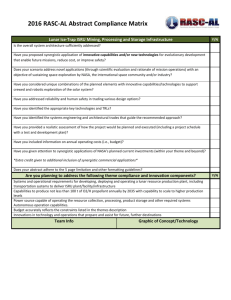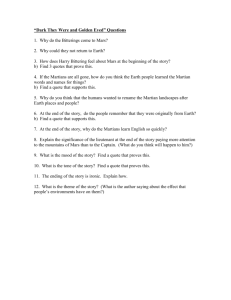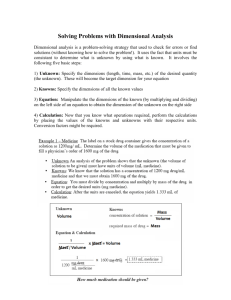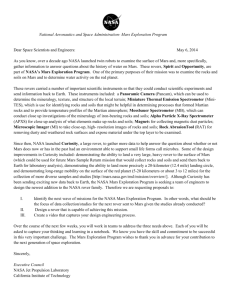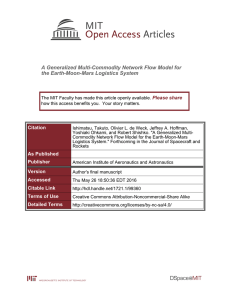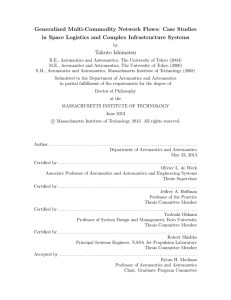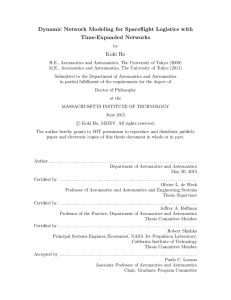Report on the Human Mars Landing Site Conference
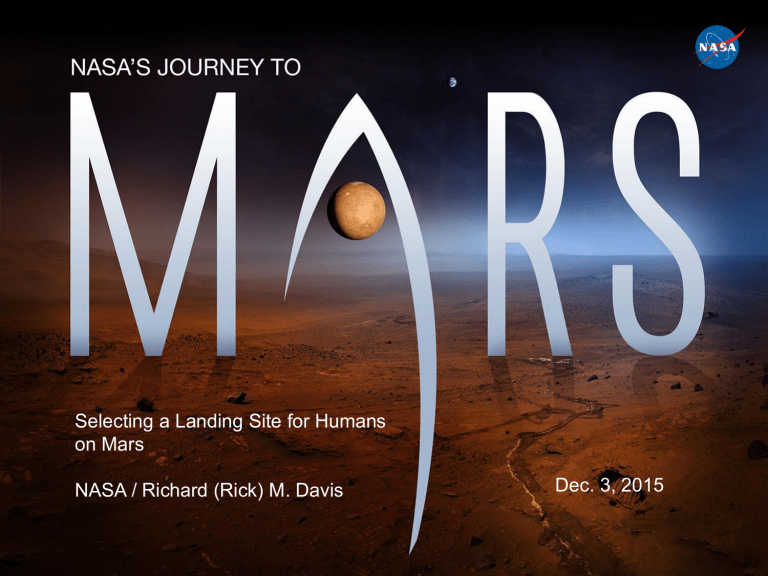
Selecting a Landing Site for Humans on Mars
NASA / Richard (Rick) M. Davis
Dec. 3, 2015
1
Human Landing Sites / Exploration Zones Workshop
Sending humans to Mars is a top NASA priority and the Agency believes that such missions will significantly expand the amount of science which can be accomplished on the planet. If carefully planned and executed, the Agency sees a natural and symbiotic interdependency between robotic and human missions to Mars.
Version 5-4 / 2
Goals of the Human Landing Sites Study
• Identify landing sites for human surface exploration of Mars.
– These landing sites provide access to Exploration Zones which are regions on Mars that contain multiple sites of scientific interest as well as satisfying engineering and human constraints for human exploration
– Leverage Mars Reconnaissance Orbiter (MRO) data collection capabilities to acquire data of potential prioritized human Mars landing sites within the exploration zones.
– Exploration Zones will be chosen to maximize science return as well as support human operations.
– This work will result in a database of high science interest sites, which can easily be updated as we learn more about Mars and what is needed to support humans on the planet.
This effort is a joint HEOMD/SMD study.
Version 5-1 / 3
Science ROI’s
Exploration Zone Layout
Habitation Zone
Resource ROI
Science ROI’s
ROI = Regions of Interest
Science ROI
Resource ROI
Version 5-4 / 4
Response to Call for Proposals
Response was strong: 45 EZ proposals covering the entire planet
Key Requirements for Exploration Zones:
Permanent Research Outpost
Diverse Science and ISRU ROIs
Access to Water
Pinpoint Landings are assumed and required
+/- 50 degrees latitude
+2 miles MOLA altitude
Version 5-4 / 5
Workshop Results
• Highly diverse and, for the most part, well developed EZ proposals
(particularly for this stage in the process)
•
Strong agreement on the viability of the Exploration Zone approach based on
EZ proposals made
• Critical involvement by science, engineering, ISRU, and operations communities
– Starting to build an integrated community is a critical result of the workshop
• Strong consensus that more advanced reconnaissance at Mars will eventually be needed to ultimately pick the human landing site / exploration zone
Version 5-4 / 6
Access to water is becoming a defining attribute.
Water feedstock options:
“Sheet” Ice Debris-Covered Glaciers
Recurring Slope Lineae
Poly-hydrated Sulfates
Other Options:
- Hydrated Dunes
- Atmospheric H2O
Many EZs had multiple water feedstock types
Hydrated Minerals
Version 5-4 / 7
Next Steps
• We are soliciting feedback from all 175 workshop participants on the EZ proposals as well as on the process
– Dec 18: Telecon with all workshop participants to review feedback and next steps
• We will be prototyping to determine how we actually image something as large as an
EZ
• MRO imaging requests in the proposals are being assessed for implementation as soon as possible
•
As a result of the Workshop, other needed steps becoming much clearer:
Splinters are probably needed to
– Narrow water options down and to figure out how we might use our current fleet at
Mars to help with this
– Define ISRU production options for each type of feedstock: mass of production equipment needed at Mars and power levels required
•
Goal would be to down select some water feedstock options and then have teams propose updated/new EZs based on that downselect
– Next workshop is probably 1.5 years from now
Version 5-4 / 8
Significant Media Interest in the Workshop
•
Local, national, international and social media
• Multiple on-site interviews
• Participants and non-participants used Twitter to share workshop content
NASA TV Social Q&A
Version 5-4 / 9
The Team
Version 5-4 / 10
Signed Workshop Poster
Version 5-4 / 11
Backup
Version 5-4 / 12
Key Links
• Criteria for an Exploration Zone (EZ) http://www.nasa.gov/sites/default/files/atoms/files/hls2-2nd-announcement-
7-8.pdf
• Link to EZ Presentations: http://www.nasa.gov/feature/mars-human-landing-site-workshoppresentations/
• YouTube Link for actual EZ presentations: https://www.youtube.com/playlist?list=PLQ7WzZtgqMBAKEHnjfoTR3vPtMSnoM-D
• YouTube link for Social Q&A: https://www.youtube.com/watch?v=QitHojL7tOA&index=15&list=PLQ7WzZt g-qMBAKEHnjfoTR3vPtMSnoM-D
For more information, contact
NASA-Mars-Exploration-Zones@mail.nasa.gov
Version 5-4 / 13
Science Objectives
Astrobiology:
• LIFE : Search for evidence of past or present life Investigate the exchange and cycling of material between the subsurface, surface and atmosphere.
• CHEMISTRY : Investigate the complex chemistry, including mechanisms for organosynthesis, alteration and destruction.
Atmospheric Science:
• PRESENT CLIMATE & WEATHER : Quantify the atmospheric state and driving forces of the present atmosphere
– Characterize the local source and sinks in the dust, water and CO
2 cycles, and the key parameters that
– Quantify photochemical and electrochemical cycles and potential subsurface trace gas sources
• PAST CLIMATE : Constrain past climate states and atmospheric composition, particularly as recorded in trace gases and surface morphology and composition
Version 5-4 / 14
Science Objectives (cont.)
Geosciences:
• GEOLOGY : Characterize the composition and evolution of surface units and evaluate the diverse geologic processes and paleoenvironments that have affected the martian crust;
• AGES : Determine relative and absolute ages of geologic events and units, and relate their ages to major events through martian history.
• INTERIOR GEOPHYSICS : Constrain the dynamics, structure, composition and evolution of the martian interior
Cross-Cutting:
• WATER : Determine the availability of water, as vapor, ice or in hydrated materials in the near-surface environment
• HUMAN IMPACTS : Characterize the impact of humans on the martian environment.
• RADIATION : Evaluate variability in the martian radiation environment.
Version 5-4 / 15
ISRU/Civil Engineering Criteria
• Access to raw material that exhibits the potential to (a) be used as feedstock for water-generating In-Situ Resource Utilization (ISRU) processes and (b) yield significant quantities (>100MT) of water. Raw material can be in the form of ice, ice/regolith mix, or hydrated minerals and the top of the raw material deposit should be as close to the surface as possible
•
Access to a region where infrastructure can be emplaced or constructed.
This region must be less than 5 km from a central landing site and contain flat, stable terrain. The region should exhibit evidence for an abundant source of cobble-sized or smaller rocks and bulk, loose regolith. Natural terrain features that can be adapted for construction purposes (e.g., to enhance habitat radiation protection) are considered beneficial
• Access to raw material that exhibits the potential to be used as metal or silicon feedstock for ISRU and construction purposes. Of primary interest are iron, aluminum, and silicon; titanium and magnesium are of secondary interest. Raw material should be as near to the surface as possible and be in a form that can be mined by highly automated systems
Version 5-4 / 16
Engineering Constraints
• Located between +/- 50 degrees latitude
• Less than +2 km altitude (Mars Orbiter Laser Altimeter (MOLA) reference)
• An area of approximately 25 km 2 within which the terrain is generally level
(slopes less than ~10 degrees) and significantly devoid of landing hazards
(e.g., large and/or closely concentrated craters, mountainous terrain, broken/jumbled/chaotic terrain, extensive dune fields, etc.)
• Does not contain thick deposits of fine-grained dust (e.g., extremely low thermal inertia and high albedo)
Version 5-4 / 17
